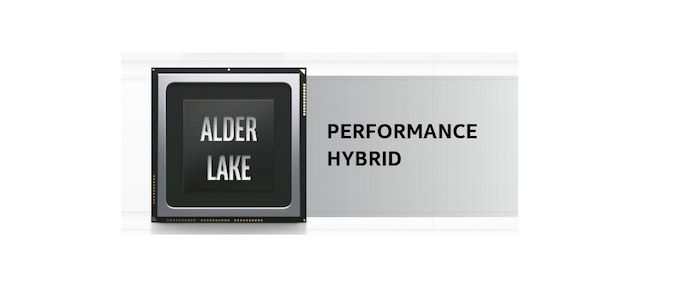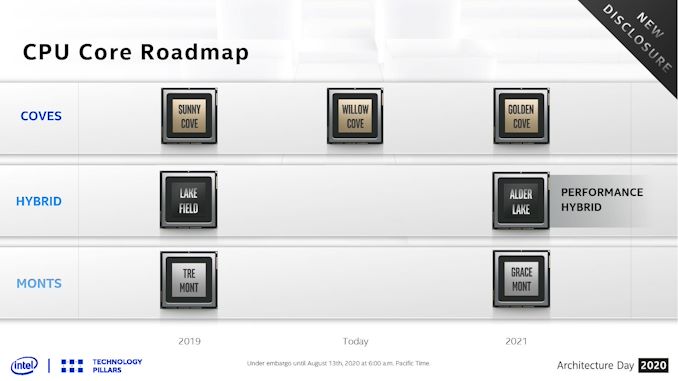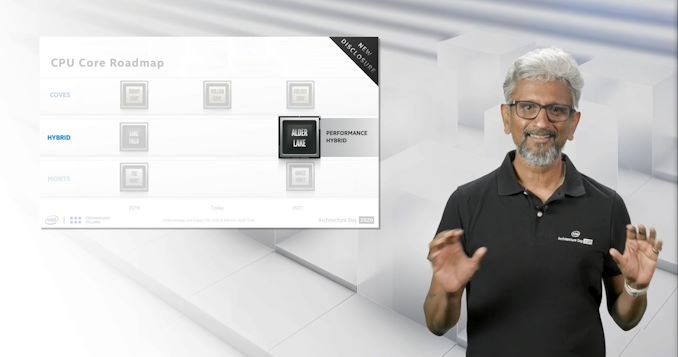Intel Alder Lake: Confirmed x86 Hybrid with Golden Cove and Gracemont for 2021
by Dr. Ian Cutress on August 14, 2020 1:05 PM EST- Posted in
- CPUs
- Intel
- Alder Lake
- Hybrid
- Intel Arch Day 2020

Following leaks is often a game of cat and mouse – what is actually legitimate and what might not be. Traditionally AnandTech shies away from leaks for that very reason, and we prefer to have multiple sources that are saying the same thing, rather than addressing every potential rumor on the blogosphere. Nonetheless, hints towards a new product from Intel, Alder Lake, have been cropping up over the past few months, including getting a small mention in Intel’s Q2 2020 earnings. The leaks have suggested that it would offer a mixed Hybrid x86 environment similar to Intel’s current Lakefield product that uses high-performance cores paired with high-efficiency cores. As part of Intel’s Architecture Day 2020, the company officially announced Alder Lake as a hybrid x86 product on its roadmaps.
In the roadmap and as part of the discussions, Intel’s Raja Koduri confirms that Alder Lake will be a combination of the Golden Cove high performance computing core and the Gracemont high efficiency core, and the goal of this chip is to offer a ‘Performance Hybrid’ option into the portfolio. Raja explained to the audience that the company has learned a lot due to building Lakefield, its current hybrid x86 chip for thin and light notebooks, and while Lakefield was focused on battery life, Alder Lake will focus instead on performance.
Alder Lake will involve Intel’s next generation hardware scheduler, which we are told will be able to leverage all cores for performance and make it seamless to any software package. Intel claims that Alder Lake will be Intel’s best (ever? 2021?) performance-per-watt processor.
If leaks are to be believed, then Alder Lake looks set to offer an 8+8 design, although that has not been confirmed. Intel did not go into detail if Alder Lake will involve any next generation packaging, such as Foveros (which Lakefield does) – but in the Q2 2020 financial disclosures, it was said to be positioned for mobile and desktops. We expect Intel to discuss Golden Cove and Gracemont at some point next year, and then Alder Lake as an extension to those – we have already seen Intel documents regarding new instructions for each of these cores. My prediction is to come back this time next year, where we should have more to talk about.
Related Reading
- Intel Updates ISA Manual: New Instructions for Alder Lake, also BF16 for Sapphire Rapids
- Intel Roadmap Update: Alder Lake In H2’21, Ice Lake-SP Late This Year
- Intel’s 11th Gen Core Tiger Lake SoC Detailed: SuperFin, Willow Cove and Xe-LP
- The Intel Xe-LP GPU Architecture Deep Dive: Building Up The Next Generation
- The Intel Lakefield Deep Dive: Everything To Know About the First x86 Hybrid CPU












89 Comments
View All Comments
FXi - Sunday, August 16, 2020 - link
TL is launching for ultrabooks which of course has overlap for notebooks. But in reality the H series mobile chip isn't going TL until 2021 and while it's thought to be Q1 frankly we could be at this same time a year from now still wondering where Tiger Lake H chips are. And by this time next year AMD will have cleaned Tiger Lake's clock (so to speak).Santoval - Saturday, August 15, 2020 - link
Tiger Lake will be released up to an -H series (i.e. middle TDPs of 35 - 45W), maxing at 8 cores. I have no idea if Intel mean -H for desktop or for heavy duty laptops though. It might, and should, be both. -S series and HEDT series will be covered by Rocket Lake, which will also almost certainly be released for -H, -U and -Y series as well because Intel's still problematic 10nm+ node cannot fully cover the market demand due to inadequate yields.However while in the previous generation roughly 4 Comet Lake-U/Ys were fabbed for each Ice Lake-U/Y Intel plan to significantly increase the production of Tiger Lake-U/Y/Hs so that the split between them and the equivalent Rocket Lakes is somewhere between 2 Rocket Lakes for each Tiger Lake and (optimistically) an even split of both. Alder Lake, fabbed at 10nm++, is planned to be Intel's first top to bottom single release 10nm part, in other words Intel plans (or... hopes) to finally ditch their 14nm+++++ node next year..
Tiger Lake-U/Y/H is expected to have a faster iGPU than AMD's APU 4000 series due to AMD insisting on employing a 2017 iGPU μarch in their APUs - and even worse, they plan on using the same iGPUs in their Zen 3 sporting 5000 APU series next year. As insane as that sounds AMD plan to deliver the APU / laptop market back to Intel before they even took an appreciable slice from it, which is bizarre and disappointing. Tiger Lake might also have faster CPUs (if Intel can deliver high clocks), while the -H 8-core version might beat AMD's fastest -H APUs in all metrics : single core, multi core *and* GPU performance.
Intel's Xe (iGPUs) are expected to decimate Vega iGPUs and so surpass AMD in iGPU performance for the first time since... ever? Well, if Intel's brand new 2020 GPU tech couldn't even surpass AMD's 2017 iGPU tech Intel would be in big trouble..
nandnandnand - Saturday, August 15, 2020 - link
Renoir is meant to be paired with a discrete mobile GPU, although even that is a problem since it can't support the most powerful ones. On the other hand, the most expensive and powerful laptops sell less units.It looks like they will put the good graphics (RDNA/RDNA2) in Van Gogh, and make modest iGPU improvements in Cezanne, but probably fix the PCIe bandwidth issue at that time.
Spunjji - Monday, August 17, 2020 - link
"even that is a problem since it can't support the most powerful ones"Yes it can. It has 8 PCIe 3.0 lanes dedicated to graphics which is more than sufficient to support the highest-end laptop GPUs.
This bizarre rationalization needs to die. It *can support the best graphics chips*, it's just that *no OEM will pair them up*. Nobody knows why for sure, but it's not down to the PCIe lanes.
nandnandnand - Monday, August 17, 2020 - link
You sure?https://www.igorslab.de/en/manufacturers-when-gami...
vladx - Thursday, August 20, 2020 - link
Just more Spunjii nonsense, some games already started to show difference between PCIe 3.0 x8 and x16, this will become more and more apparent in the future.KimGitz - Sunday, August 16, 2020 - link
I'm interested to see 10nm SuperFin Tiger Lake H with 8 Willow Cove Cores, Xe-LP, LPDDR5, PCIe 4.0 (dGPU+NVME SSD) and Thunderbolt 4|USB4 USB-C.I don't see Tiger Lake bringing any form factor design changes. More the laptop performance playing catch up with the desktop.
Alder Lake on the other hand could help usher longer battery life and even lighter devices. I say this considering the performance of Lakefield which only has 1 Sunny Cove and the 4 Tre Mont Cores do most of the lifting. Alder Lake will be on an advanced SuperFin (whatever that means) will have upto 8 Golden Cove cores (improved Willow Cove) and upto 8 Grace Mont cores. Not only will it be improving on the 8 Big cores found in Tiger Lake H but will be adding 8 small Cores which as we have seen with Lakefield can be very efficient. The improved scheduler will help future laptops ran cooler, quieter and longer since most of the day to day tasks will ran on the small cores. In fact I don't think we will see many laptop designs with 8 Big Cores, it will be more common to see gaming ultra portables with 6 big cores + 8 Little Cores + GT2 (iGPU) + dGPU. The bigLittle design prefers the Little cores and calls upon the big cores to boost performance or short bursts of performance.The little cores will handle typical tasks like Web browsing, Word processing well.
I really hope Intel can get Alder Lake out and swe see healthy competition between x86 x64 vs ARM, and between Intel, AMD, Nvidia, Qualcomm and Apple chip designs.
Spunjji - Monday, August 17, 2020 - link
"...which as we have seen with Lakefield can be very efficient..."Why are so many people talking like this is a product that has already released and been tested? Can anyone buy it yet? The only info I've seen was that early leak from Notebookcheck.
Valantar - Tuesday, August 18, 2020 - link
... because it has? There's at least a Samsung laptop available with Lakefield, and it's been reviewed extensively.vladx - Thursday, August 20, 2020 - link
Lmao @Spunjii busted again.